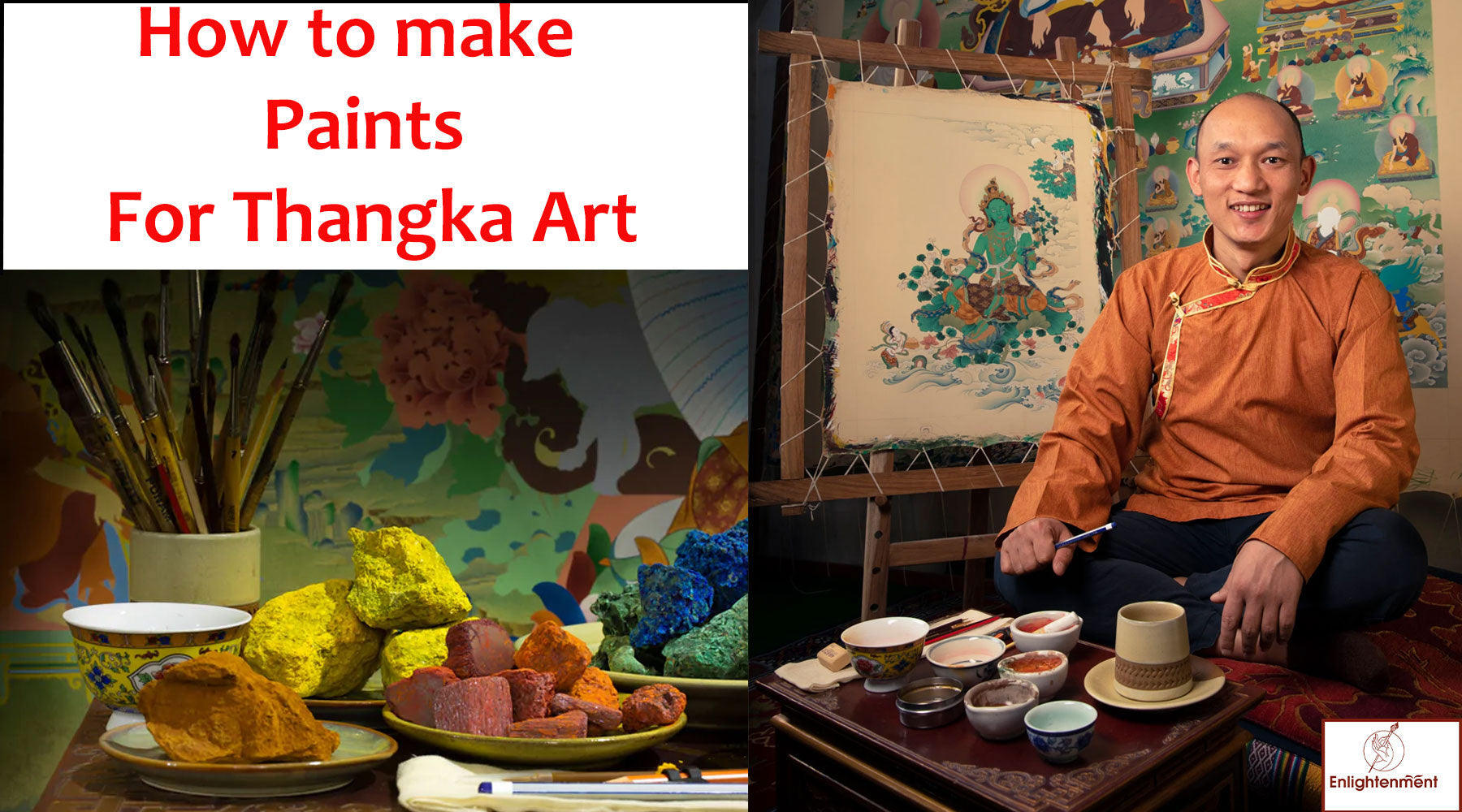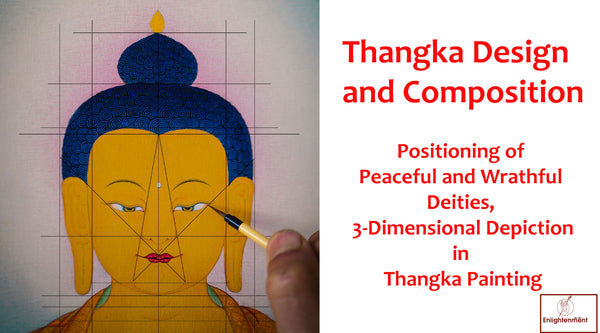Paints for Thangka Painting
Thangka paintings are composed of different hues of pigments. Traditionally glue and pigments in a water-soluble media and natural stone colors were primarily used. But both organic and inorganic pigments are still employed today. The natural stone colors are extracted, crushed, and then transformed into usable paints. Various painters use wood dust, flowers, and acrylic paints. The painting was created using delicate brushes.
Alongside Natural stone colors and Acrylics, gold is also used to paint the Thangka. Different steps are involved in each type of paint's extraction and making process.
Gold and Silver Paint
Pure gold should be beaten into thin sheets and chopped with scissors into tiny bits to create gold paint. You should follow the 1:3 ratio, meaning 1 gram of gold and 3 grams of white sea salt should be added before being pounded with a wooden pestle. It is crucial to pound it rather than grinding it, as if with a hammer. Allowing the gold dust to settle to the bottom and then draining out the liquid again until the object is fully clean will remove the salt. After that, add a bit of chang and skin glue, careful not to put too much or too little. Once more, pound the gold slowly and gently with a stone pestle until it is fine.
Any gold that rises to the surface is removed and put into a clean vessel for collection. The remaining material is kept clean and dust-free as it is further ground until converted into a fine powder. Finally, clean it once more by removing the liquid as previously described, being careful not to lose any of the gold. As many times as necessary to get it clean.
Click here to view High Quality Hand-Painted Thangka Painting
Salt, alcohol, skin glue, and a sukpa (medicinal plant for washing) are essential to make gold paint. After processing the gold, various organic dyes can be applied to change the color. The first one is created by mixing and boiling tarbu (the berries of the common sea buckthorn or hippophae rhamnoides shrub), sedru (pomegranate juice), and sertsur, which are.
Use the dye generated after these three have been heated with water to color the gold by heating them all again. Add the tso dye (Indian madder or Rubia cordifolia) and boil them together to get gold that is more orange in color. Heat a little quantity of a nyangtsi and saffron-based dye and mix it with the gold to add a more yellow hue. Heat the gold and nga marpo (red aconite) bone together for a reddish tint.
Preparing silver is similar to processing gold for use in painting or calligraphy. But this approach is a little simpler: In a stone kettle, add a good amount of charcoal from La Ma, pour in the hot silver, and swiftly pound them together before they cool. It is advisable to thoroughly grind them at this point so that additional processing is unnecessary; the mixture will then produce a coarse powder similar to tsampa, which is simple to grind further into a fine powder. Put the leftover pure silver powder in a stone mortar after separating the charcoal from the silver using hot water in the same manner as for gold.
Similar to that processing of gold, use hot water to separate the silver from charcoal and then put the leftover pure silver powder in a stone mortar after. Once more, add water, refine, and grind the mixture until very fine. Then drain the water, mix in the pomegranate juice, bring to a boil, and then remove. This is the right way to clean and purge impurities from silver, which gives it an exquisite shine.
Alternately, mix tarbu, bultok (soda), and salt. This mixture should be added to the silver and heated while stirring to dissolve the oxide. This combination will get white, bright, and pure if you combine and stir it repeatedly before it cools. Additionally, if it is further processed with pomegranate juice and a chang mixture, it will emit a fine luster shine.
Mineral Pigments
Mineral blue and green
Since the first two colors applied to the Thangka are the blue sky and the green grass, blue and green are presented first. The minerals utilized are formed of the fundamental copper carbonates such as azurite and malachite (also exist together in nature). They were mainly imported into Tibet from Nyemotang in the Tsang region. They have a sand-like appearance and are available in three hues: azurite blue, malachite green, and turquoise. First, these must be cleaned, ground, and divided into values for each color. Warm water is used to swirl and rinse the sand to clean it. Impurities are poured off when it has settled.
A small amount of glue is then poured and kneaded, and pushed between the hands before being cleaned as usual with warm water. The pigment is put in a mortar and ground with a bit of water, and this process is repeated until the water is clear. Through this cleaning and grinding procedure, the colors become incredibly distinct. You shouldn't grind this pigment too finely, or the color will fade. Different hues are produced when the various grades of the powdered mineral are separated using the customary cleaning procedure; lighter particles are drained out and take on a clearly different color.
In this way, the single stone gives rise to the colors blue, green, and turquoise, or four hues if you count light blue.
Mineral vermilion red
Cinnabar stone is a mineral utilized in Tibet to make a red hue. Cinnabar, primarily derived from southeast Tibet, has the appearance of a crushed, brilliant red crystal. The lowest-quality stone is black and opaque, whereas the medium-quality stone is bright red. Like azurite and malachite, it needs to be cleaned and ground. Although metallic, it is a soft mineral that can be easily ground, even in a ceramic cup. It can first be ground without water if it is very pure. If not, it needs to be crushed and cleansed with water like blue and green. The powder is combined with an equal amount of an arura-derived liquid (myrobalan or amla), which is then allowed to sit for one night in a clean environment.
It is poured off when the liquid turns yellow, and the pigment is pounded till smooth, which may be done quickly and effectively. There are three iterations of this. Vermilion red should typically be ground for a very long time with very little water until it is smooth. To prevent it from turning white, grind it gently but thoroughly, using an equal mixture of circular and up-and-down motions. Add some skin adhesive at the end and continue to grind it softly in the same manner. It is then prepared for usage.
Several techniques change the red's hue: Pouring off the yellow water after adding the arura liquid will produce more orange-red. Instead, reduce the amount of yellow water removed. Add kasi to make the red stronger if necessary, then add kaping to make it even stronger. As previously mentioned, add the arura juice and repeatedly drain off the yellow water to achieve a clear red tint. You can add salt water to it to make it redder.
Other Pigments
The minerals needed to make white, yellow, and black can be ground relatively finely. Most pigments must be ground when dry, except blue, green, and red. Always take care to maintain them clean and dust-free.
Sindura, also known as minium orange, is the customary Tibetan pigment for the color orange. This was brought in from Nepal, India, and China. It can be cleaned using the standard procedure if necessary, but as it is already very soft, it shouldn't require much more processing. Red and orange should never be combined since the mixture will rot, especially if orange makes up a more significant portion of the mix. Orpiment Yellow, a mineral pigment made of arsenic trisulfide, is the color used for yellow.
The majority came from eastern Tibet, close to Chamdo. The worst grades are greenish, while the best is pure yellow. It is thick and soft. Green and orpiment yellow should never be combined since they rot. They shouldn't be painted on top of one another for the same reason. Arsenic disulfide was another substance used to create orange-yellow. Mineral limonite was used to make yellow ocher. Mainly, this served as the undercoat for gold. Calcium white, an earth pigment used to create white, is most likely primarily composed of calcium carbonate, the primary ingredient in limestone, marble, and chalk.
After the primary painting areas have been filled in with mineral paints, the shading and line work are completed with organic dyes (tö). Line and shading colors in red Lac dye are used to create the red line and shading. The resins released by the tiny lac insect are used to make this (laccifer lacca). Tibetans either extracted the color themselves or imported it in processed form from China or India. It is melted in hot water outside after being cleansed and crushed. To aid in the dye extraction, one leaf of the zhumkhen plant is added—likely cassia—and kept in the sun. To hasten the color's appearance, a little salt might be applied.
The process can be speed up by slowly heating the ingredients on the stove by placing a small pot of the elements within a bigger pot of water and tea leaves. The color will then start to show without turning black like it does when heated directly on the stove. This is primarily used for red shading, but it may also be used for red lines if it is heated and condensed further till it becomes darker.
Indigo
Traditionally, the only source of indigo was plants, primarily species of the genus Indigofera. These days, it is scarce to find. Thangka painting only made use of the finest indigo. It should be repeatedly moistened and ground over a long period. At the very end, a little adhesive is added. The procedure could take a few days. Blue lines and shading are done in indigo. The primary teachings of part two are now complete.


